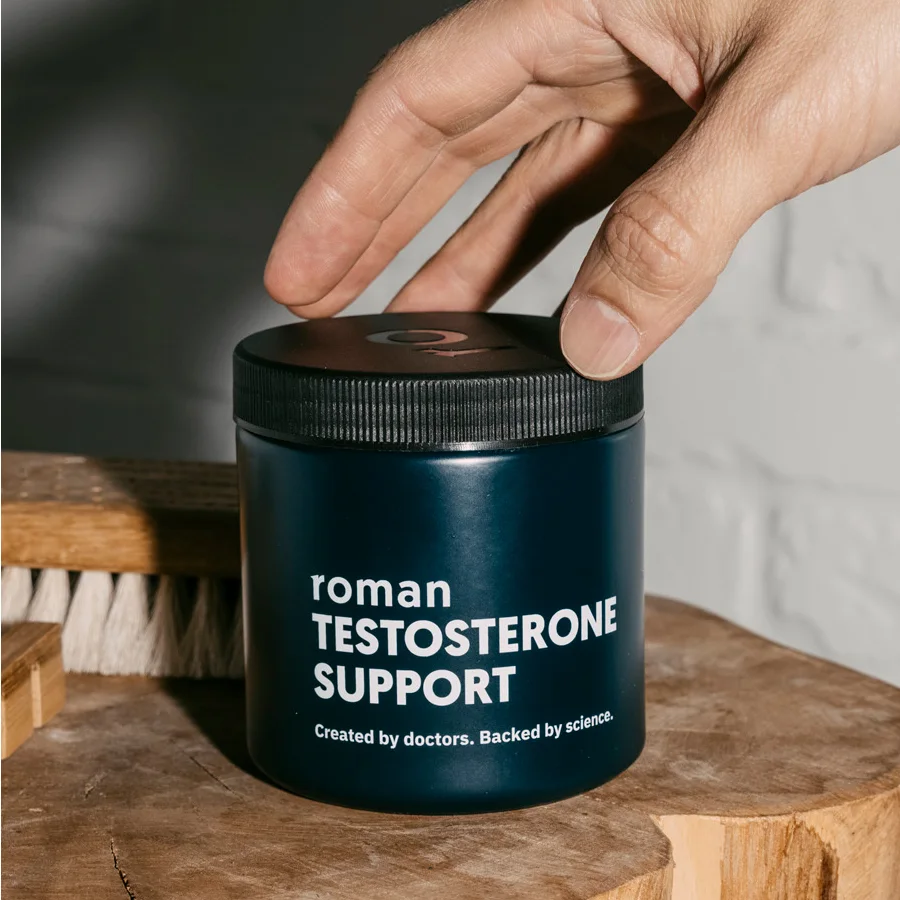Here's what we'll cover
Here's what we'll cover
Here's what we'll cover
Even before the COVID-19 pandemic moved many provider visits to your living room couch, at-home health testing was a booming industry. Today, test kits allow you to check everything from food sensitivities to fertility, all from the comfort of your home. One of those home tests is a testosterone kit. Read on to learn more about these testing kits, signs of low testosterone (or low T), and treatments.
How to test testosterone levels
Testosterone tests check your testosterone levels. One option to measure your testosterone is to visit a healthcare provider for a blood test. Because testosterone levels fluctuate throughout the day and peak in the mornings, healthcare providers generally require two blood tests from different mornings to diagnose low T.
Your provider may also request tests for luteinizing hormone (LH), follicle stimulating hormone (FSH), and prolactin, which could indicate other underlying conditions that may cause low T (UCF, n.d.).
If you’d rather avoid visiting your healthcare provider’s office, you may want to try an at-home testosterone test kit, available online and in stores. With testosterone test kits, you collect a sample and mail it back to a lab (via a prepaid shipping label). After you send the kit back, your results are usually provided by email or online within a few business days.
There are three types of at-home testosterone test kits:
Saliva: With this test, you collect your saliva in a tube and mail it to a lab. Unfortunately, the use of saliva testing for testosterone is controversial. Some studies have found that salivary and blood testosterone levels are closely correlated, while others found they don’t match up (Arregger, 2007; Adebero, 2020; Fiers, 2014). One review noted that sample collection methods and storage of salivary tests could significantly impact accuracy, and small amounts of blood in your saliva can also impact results (Groschl, 2008).
Dried blood spot (DBS): With DBS testing, you prick your finger with the supplied tool, apply blood to the testing paper, and mail the kit to a lab. One small study determined DBS testing is as accurate as traditional blood testing for hormones like testosterone (Salamin, 2021).
Microtainer: With this safe and easy approach to measuring hormones in your blood, you prick your finger with the supplied tool and add a few drops of blood to a small tube. Just like the venous tubes in phlebotomy labs, these tubes are designed for transporting a blood sample to a lab for testing. Microtainer tests are intended to replicate traditional in-lab or in-clinic testing as closely as possible with a finger prick at home, and they can also measure a similar set of hormones that healthcare providers test for at the doctor's office. Peer-reviewed research regarding the accuracy of such tests is limited.
What is a normal testosterone level?
What’s considered a “normal” testosterone level differs for men and women.
For men
The exact cut-offs for normal testosterone levels in men vary, but estimates typically range from 300–1,000 ng/dL. According to the American Urological Association (AUA), a total testosterone hormone level below 300 ng/dL indicates low testosterone in men, also known as hypogonadism (Mulhall, 2018). Healthcare providers might still treat someone with slightly higher T levels if the signs and symptoms are typical of low T.
For women
For women who are not in menopause, the normal range for total testosterone is around 15 to 46 ng/dL (Kanakis, 2019).
Unfortunately, testosterone deficiency and testosterone replacement therapy (TRT) haven’t been thoroughly studied in women, and the threshold for low testosterone in women hasn't been conclusively defined. However, some women with low testosterone levels have found testosterone therapy effective at restoring sexual desire (Davis, 2016).
Women can also suffer from hyperandrogenism, where testosterone or other androgen levels are too high. Hyperandrogenism has several potential causes, including (Rasquin, 2021):
Polycystic ovary syndrome (PCOS)
Late-onset congenital adrenal hyperplasia
Ovarian or adrenal tumors
Cushing syndrome
Certain medications
Idiopathic hyperandrogenism (no known cause)
Symptoms of low testosterone in men
For men, the symptoms of low testosterone can include (Sizar, 2021):
Low sex drive (libido)
Decreased muscle mass
Reduced semen volume
Sleep problems, like sleep apnea
Low T is more common as men get older. Testosterone levels fall about 1–2% a year, starting around age 40 (Miah, 2019)
Symptoms of low testosterone in women
For women, the symptoms of low testosterone can include (Wierman, 2014):
Decreased sexual desire
Decreased sexual sensitivity
Decreased arousal and ability to orgasm
Fatigue
Low testosterone hasn’t been thoroughly studied in women, so it’s unclear how many women experience low T (Davis, 2016).
Symptoms of high testosterone in men
High testosterone levels don’t usually happen naturally; if they do, it’s rare. In men, the most common cause of high testosterone is abusing anabolic steroids or taking too much testosterone prescribed by a healthcare provider. Symptoms of high testosterone include (Ganesan, 2021):
Gynecomastia (male breast tissue development)
Worsening of sleep apnea
Fluid retention
Testicular shrinkage
Low sperm count
Increase in red blood cells (erythrocytosis)
Symptoms of high testosterone in women
In women, high testosterone levels are most commonly caused by polycystic ovarian syndrome (PCOS), which occurs in up to 12% of women and is the most common female hormone disorder. Signs of hyperandrogenism in women include (Rasquin, 2021):
Hair loss on the scalp
Excess facial and body hair (hirsutism)
Deepening of the voice, growth of the larynx (or Adam’s apple), and clitoral enlargement—these symptoms may also indicate a tumor and should be investigated immediately.
High or low testosterone levels can cause frustrating symptoms. Fortunately, there are many options available to test your testosterone levels. Whether you use an at-home testosterone test kit or visit a healthcare facility to test your hormone levels, a healthcare provider can help you develop a treatment plan to address your symptoms.
DISCLAIMER
If you have any medical questions or concerns, please talk to your healthcare provider. The articles on Health Guide are underpinned by peer-reviewed research and information drawn from medical societies and governmental agencies. However, they are not a substitute for professional medical advice, diagnosis, or treatment.
References
Adebero, T., McKinlay, B. J., Theocharidis, A., et al. (2020). Salivary and serum concentrations of cortisol and testosterone at rest and in response to intense exercise in boys versus men. Pediatric Exercise Science , 32 (2), 65–72. doi:10.1123/pes.2019-0091. Retrieved from https://pubmed.ncbi.nlm.nih.gov/31770720/
Arregger, A. L., Contreras, L. N., Tumilasci, O. R., et al. (2007). Salivary testosterone: a reliable approach to the diagnosis of male hypogonadism. Clinical Endocrinology , 67 (5), 656–662. doi:10.1111/j.1365-2265.2007.02937.x. Retrieved from https://pubmed.ncbi.nlm.nih.gov/17953627
Bassil, N., Alkaade, S., & Morley, J. E. (2009). The benefits and risks of testosterone replacement therapy: a review. Therapeutics and Clinical Risk Management , 5 (3), 427–448. doi:10.2147/tcrm.s3025. Retrieved from https://www.ncbi.nlm.nih.gov/pmc/articles/PMC2701485/
Braunstein, G. D., Reitz, R. E., Buch, A., et al. (2011). Testosterone reference ranges in normally cycling healthy premenopausal women. The Journal of Sexual Medicine , 8 (10), 2924–2934. doi:10.1111/j.1743-6109.2011.02380.x. Retrieved from https://pubmed.ncbi.nlm.nih.gov/21771278/
Davis, S. R. & Wahlin-Jacobsen, S. (2015). Testosterone in women--the clinical significance. The Lancet: Diabetes & Endocrinology , 3 (12), 980–992. doi:10.1016/S2213-8587(15)00284-3. Retrieved from https://pubmed.ncbi.nlm.nih.gov/26358173/
Davis, S. R., Worsley, R., Miller, K. K., et al. (2016). Androgens and female sexual function and dysfunction--findings from the fourth International Consultation of Sexual Medicine. The Journal of Sexual Medicine , 13 (2), 168–178. doi:10.1016/j.jsxm.2015.12.033. Retrieved from https://pubmed.ncbi.nlm.nih.gov/26953831/
Demers, L. M. (2010). Androgen deficiency in women; role of accurate testosterone measurements. Maturitas , 67 (1), 39–45. doi:10.1016/j.maturitas.2010.04.019. Retrieved from https://pubmed.ncbi.nlm.nih.gov/20493647/
Fiers, T., Delanghe, J., T'Sjoen, G., et al. (2014). A critical evaluation of salivary testosterone as a method for the assessment of serum testosterone. Steroids , 86 , 5–9. doi: 10.1016/j.steroids.2014.04.013. Retrieved from https://pubmed.ncbi.nlm.nih.gov/24793565/
Ganesan, K., Rahman, S., & Zito, P. M. (2021). Anabolic steroids. StatPearls . Retrieved on Jan. 25, 2022 from https://www.ncbi.nlm.nih.gov/books/NBK482418/
Groschl, M. (2008). Current status of salivary hormone analysis. Clinical Chemistry , 54 , (11), 1759–1769. doi:10.1373/clinchem.2008.108910. Retrieved from https://academic.oup.com/clinchem/article/54/11/1759/5628672%C2%A0
Kanakis, G. A., Tsametis, C. P., & Goulis, D. G. (2019). Measuring testosterone in women and men. Maturitas , 125, 41–44. doi:10.1016/j.maturitas.2019.04.203. Retrieved from https://pubmed.ncbi.nlm.nih.gov/31133215/
Kovac, J. R., Rajanahally, S., Smith, R. P., et al. (2014). Patient satisfaction with testosterone replacement therapies: the reasons behind the choices. The Journal of Sexual Medicine , 11 (2), 553–562. doi:10.1111/jsm.12369. Retrieved from https://www.ncbi.nlm.nih.gov/pubmed/24344902
Mazer, N. A. (2002). Testosterone deficiency in women: etiologies, diagnosis, and emerging treatments. International Journal of Fertility and Women's Medicine , 47 (2), 77–86. Retrieved from https://www.researchgate.net/publication/11379745_Testosterone_deficiency_in_women_Etiologies_diagnosis_and_emerging_treatments
Miah, S., Tharakan, T., Gallagher, K. A., et al. (2019). The effects of testosterone replacement therapy on the prostate: a clinical perspective. F1000Research , 8 , F1000 Faculty Rev-217. doi:10.12688/f1000research.16497.1. Retrieved from https://www.ncbi.nlm.nih.gov/pmc/articles/PMC6392157/
Mulhall, J. P., Trost, L. W., Brannigan, R. E., et al. (2018) Evaluation and management of testosterone deficiency: AUA guideline. Journal of Urology, 200 : 423. Retrieved from https://www.auanet.org/guidelines/testosterone-deficiency-guideline
Mulligan, T., Frick, M. F., Zuraw, Q. C., et al. (2006). Prevalence of hypogonadism in males aged at least 45 years: the HIM study. International Journal of Clinical Practice , 60 (7), 762–769. doi:10.1111/j.1742-1241.2006.00992.x. Retrieved from https://pubmed.ncbi.nlm.nih.gov/16846397/
Rasquin Leon, L. I., Anastasopoulou, C., & Mayrin, J. V. (2021). Polycystic ovarian disease. StatPearls . Retrieved on Jan. 25, 2022 from https://www.ncbi.nlm.nih.gov/books/NBK459251/
Rivas, A. M., Mulkey, Z., Lado-Abeal, J., & Yarbrough, S. (2014). Diagnosing and managing low serum testosterone. Proceedings (Baylor University. Medical Center) , 27 (4), 321–324. doi:10.1080/08998280.2014.11929145. Retrieved from https://www.ncbi.nlm.nih.gov/pmc/articles/PMC4255853
Salamin, O., Nicoli, R., Xu, C., et al. (2021). Steroid profiling by UHPLC-MS/MS in dried blood spots collected from healthy women with and without testosterone gel administration. Journal of Pharmaceutical and Biomedical Analysis , 204 , 114280. doi:10.1016/j.jpba.2021.114280. Retrieved from https://pubmed.ncbi.nlm.nih.gov/34340018/
Sizar, O. & Schwartz, J. (2021). Hypogonadism. StatPearls . Retrieved on Jan. 25, 2022 from https://www.ncbi.nlm.nih.gov/books/NBK532933/
Trost, L. W. & Mulhall, J. P. (2016). Challenges in testosterone measurement, data interpretation, and methodological appraisal of interventional trials. The Journal of Sexual Medicine, 13 (7), 1029–1046. doi:10.1016/j.jsxm.2016.04.068. Retrieved from https://pubmed.ncbi.nlm.nih.gov/27209182/
Urology Care Foundation (UCF). (n.d.). Low testosterone. Retrieved on Jan. 25, 2022 from https://www.urologyhealth.org/urology-a-z/l/low-testosterone
Wierman, M. E., Arlt, W., Basson, R., et al. (2014). Androgen therapy in women: a reappraisal: an endocrine society clinical practice guideline, The Journal of Clinical Endocrinology & Metabolism , 99 (10), 3489–3510. doi:10.1210/jc.2014-2260. Retrieved from https://pubmed.ncbi.nlm.nih.gov/25279570/ .










